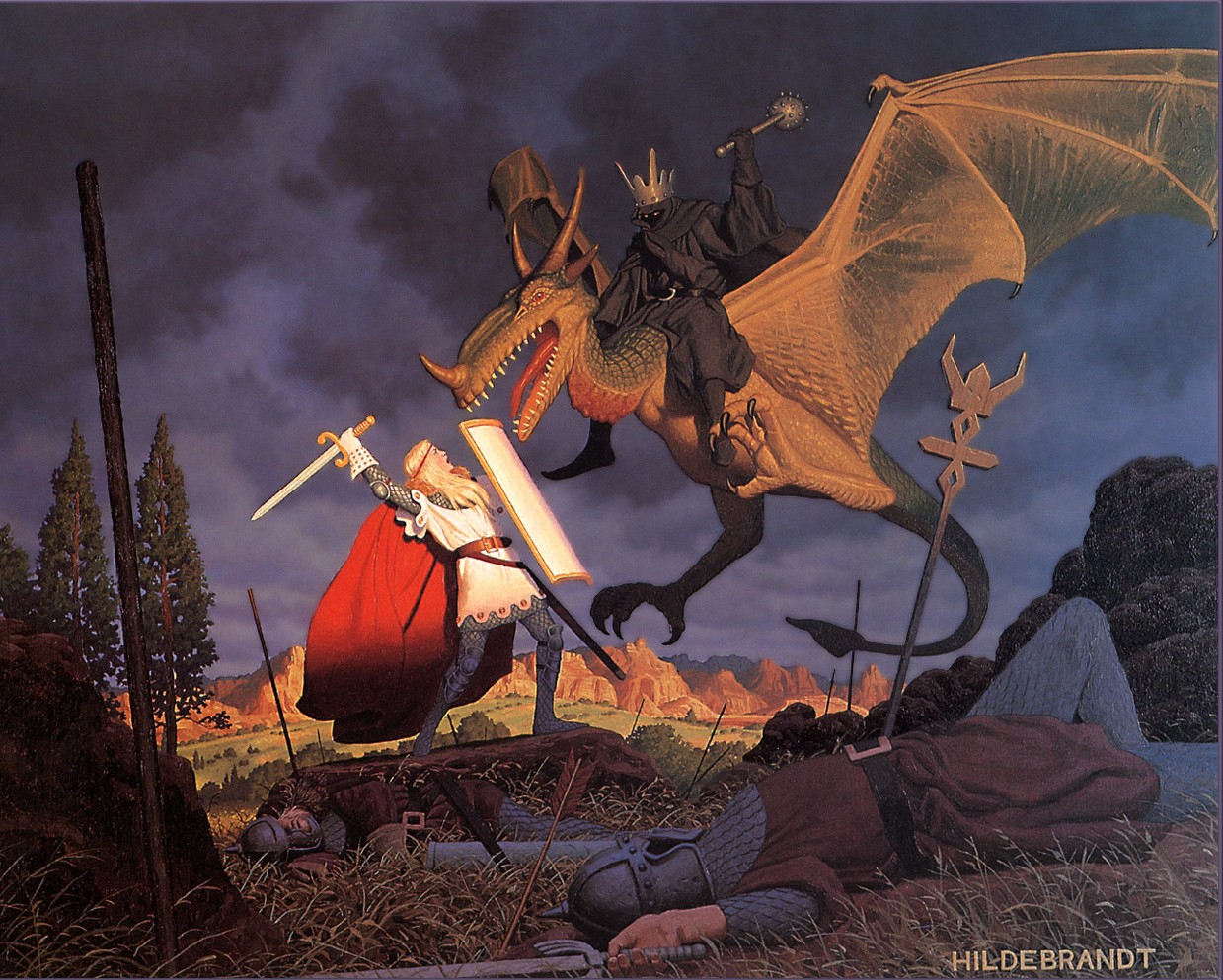
Figured out the Lord of the Rings and other Middle Earth references encoded in the scientific names of these fossil condylarths? Here is Leigh Van Valen’s original explanation of how he came up with the names. Impressive how he managed to mix in allusions to Greek, English, and Egyptian meanings for some of the names.
Oxyprimus galadrielae “Galadriel (Sindarin [Elvish], radiantly garlanded woman), wise elf-queen of the Lord of the Rings and The Silmarillion.”
Protungulatum gorgun “Gorgûn, the Woses’ name for orcs in the Lord of the Rings”
Deltatherium durini “Name of many dwarf-kings in The Lord of the Rings; Durin I began Khazad-Dûm. Allusion is to size”
Chriacus calenancus “Sindarin (Elvish) calen, green; anca, jaws. Reference is to inferred herbivory.”
Thangorodrim thalion Genus from “Thangorodrim, the mountainous triple fortress of Morgoth in The Silrnarillion. Reference is to Purgatory Hill.” [the site where the fossil was collected]. Species name “Sindarin (Elvish) thalion, strong. Reference is to the massive morphology and the generic name.”
Arctocyonides [Claenodon] mumak “Mûmak, name used in Ithilien for the animal hobbits called an oliphaunt, resembling a large elephant. Reference is to size.”
Platymastus palantir “Quenya (Elvish) palantir, distant watcher, one of 7 globes made by Fëanor that gave visions through spacetime. Reference is to the long duration of the genus.”
Platymastus [Aletodon] mellon “Sindarin (Elvish) mellon, friend, the password of the west gate of Khazad-dûm in The Lord of the Rings. Reference is to similarlty to P. palantir, presumptive diet of plants, and obliquely to the English word melon and Greek mellesis, delay, from mello.”
Mimotricentes mirielae “Míriel (Quenya, Jewel-woman), Númenorian queen in The Silmarillion, forced into marriage and the loss of her throne.”
Desmatoclaenus mearae “Meara, any one of the great horses of Rohan in The Lord of the Rings.”
Deuterogonodon noletil “Quenya (Elvish) nólë, knowledge, and til, horn. Reference is to the apparent relationship of D. noletil to uintatheres.”
Litaletes ondolinde “Quenya (elvish) ondo, rock, and lindë, song. Reference is to Rock Bench and to the hidden city Ondolindë or Gondolin of The Silmarillion. The Rock Bench specimens and others were formerly as hidden (and unsorted).”
Bomburia “Bombur, a fat dwarf in The Hobbit and The Lord of the Rings. Reference is to size and morphology.”
Protoselene bombadili “Tom Bombadil, the Hobbit name for a simple, powerful, and very old being. Reference is to these three traits.”
Litomylus (?) alphamon Sindarin (Elvish) alph, swan, and amon, hill. Reference is to the locality [Swan Hill], with allusion also to Alph, the sacred river of Xanadu; Amon, usually the Chief Egyptian god; alpha, the letter; and Greek monos, single.”
Maiorana noctiluca Maiorana is derived from Middle Latin maiorana, marjoram, with allusion to Latin decompositions as larger or May frog, and things pertaining to the larger, or to the gold of Maia or May. Quenya (Elvish), wandering angel. Allusion is to the pleasantly splcy Maiorana family.”
Tinuviel eurydice Sindarin (Elvish) tinúviel, daughter of twilight, or nightingale, Beren’s name for Lúthien in The Silmarillion. Eurydice: Eurydice vanished just before being led from Hades. Reference is to Purgatory Hill [the site where the fossil was collected], the late occurrence of this species, Lúthien’s rescue of Beren from Sauron’s dungeon, and their escape from Morgoth’s deep tunnels with a silmaril.
Fimbrethil ambaronae “Fimbrethil, entwife loved by Fangorn in The Lord of the Rings. Reference is to partly primate-like morphology and the disappearance of both Fimbrethils.” Quenya (Elvish) ambarona, one of Fangorn’s shorter names for his forest. Reference is to the dimness of the forest and of the affinities of this species.”
Mimatuta morgoth Mimatuta: “Sindarin (Elvish) mir, jewel, and Matuta, Roman goddess of dawn. Reference is to ancestral position, with allusion to Latin mius, imitator, and tuta, safe, and to Mim, dwarf of The Silmarillion, and Latin tuta, examined.” Morgoth (Quenya [Elvish] mor, dark, and goth, universal enemy). Fëanor’s name for Melkor, the power-lustful Vala of The Silmarillion. Reference is to the Hell Creek Formation.”
Mimatuta minuial Sindarin (Elvish) minuial, the time at dawn when the stars fade. Reference is to the dawn of the Cenozoic and the fading of the Mesozoic stars.”
Earendil undomiel “Eärendil [father of Elrond], who, (in the Silmarillion) sailed with a silmaril to get the aid that defeated Morgoth.” Quenya (Elvish), undómiel, evening star, which Eärendil with his silmaril became.”
Anisonchus athelas (later synonymized with Anisonchus eowynae) Sindarin (Elvish) athelas, kingsfoil, a healing plant in The Lord of the Rings. Reference is to the joining of phylogenies.”
Anisonchus eowynae Éowyn, woman of Rohan in The Lord of the Rings, who killed the chief of the Nazgûl and was cured of his poison by athelas.
Mithrandir Mithrandir (Sindarin, gray wanderer), elvish name for Olorin [i.e., Gandalf] wisest of the Istari in The Lord of the Rings. Reference is to the subtleness of the differences between the subgenera.”
Ancalagon “The mightiest dragon of Morgoth, in the Silmarillion.”
Niphredil radagasti “Sindarin (Elvish) niphredil, white-flowering forb of open woods in Neldoreth and Lothlorien.” and “Radagast, naturalist of the Istari in The Lord of the Rings.”
Reference:
L. M. Van Valen. 1978. The beginning of the Age of Mammals. Evolutionary Theory 4:45-80
1 comment